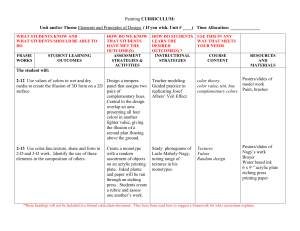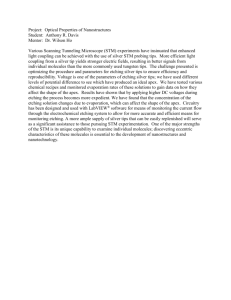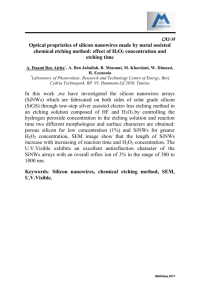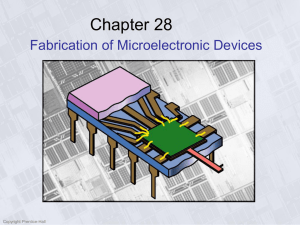efficiency enhancement of LEDs, and realization of Abstract —
advertisement
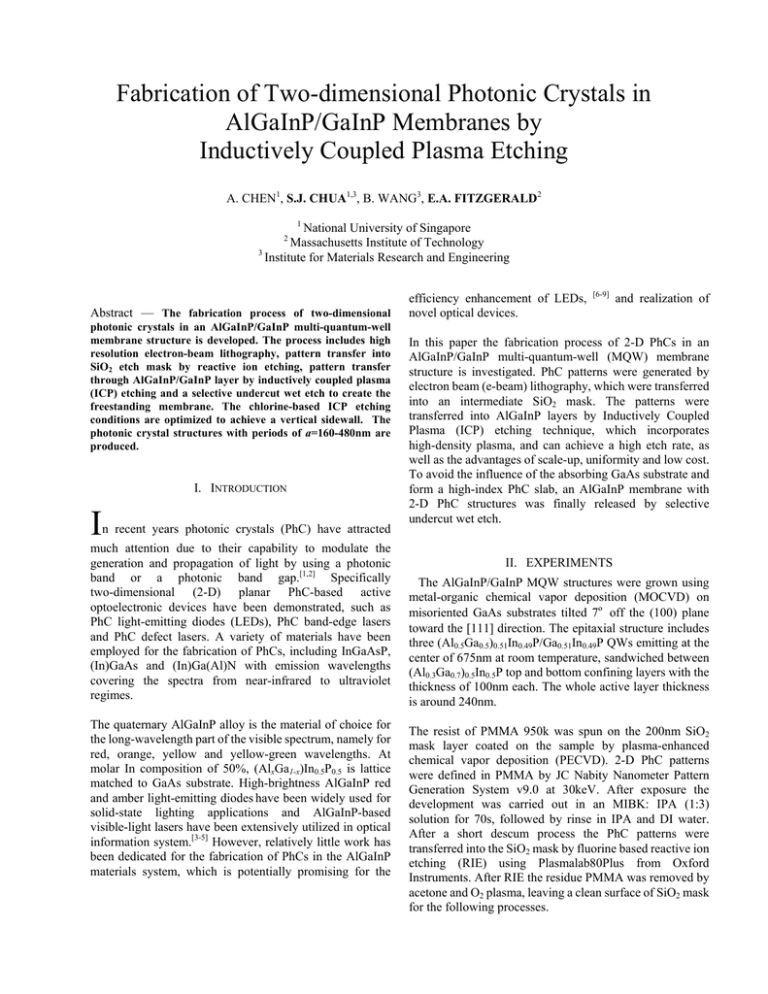
Fabrication of Two-dimensional Photonic Crystals in AlGaInP/GaInP Membranes by Inductively Coupled Plasma Etching A. CHEN1, S.J. CHUA1,3, B. WANG3, E.A. FITZGERALD2 1 National University of Singapore Massachusetts Institute of Technology 3 Institute for Materials Research and Engineering 2 Abstract — The fabrication process of two-dimensional photonic crystals in an AlGaInP/GaInP multi-quantum-well membrane structure is developed. The process includes high resolution electron-beam lithography, pattern transfer into SiO2 etch mask by reactive ion etching, pattern transfer through AlGaInP/GaInP layer by inductively coupled plasma (ICP) etching and a selective undercut wet etch to create the freestanding membrane. The chlorine-based ICP etching conditions are optimized to achieve a vertical sidewall. The photonic crystal structures with periods of a=160-480nm are produced. I. INTRODUCTION I n recent years photonic crystals (PhC) have attracted much attention due to their capability to modulate the generation and propagation of light by using a photonic band or a photonic band gap.[1,2] Specifically two-dimensional (2-D) planar PhC-based active optoelectronic devices have been demonstrated, such as PhC light-emitting diodes (LEDs), PhC band-edge lasers and PhC defect lasers. A variety of materials have been employed for the fabrication of PhCs, including InGaAsP, (In)GaAs and (In)Ga(Al)N with emission wavelengths covering the spectra from near-infrared to ultraviolet regimes. The quaternary AlGaInP alloy is the material of choice for the long-wavelength part of the visible spectrum, namely for red, orange, yellow and yellow-green wavelengths. At molar In composition of 50%, (AlxGa1-x)In0.5P0.5 is lattice matched to GaAs substrate. High-brightness AlGaInP red and amber light-emitting diodes have been widely used for solid-state lighting applications and AlGaInP-based visible-light lasers have been extensively utilized in optical information system.[3-5] However, relatively little work has been dedicated for the fabrication of PhCs in the AlGaInP materials system, which is potentially promising for the efficiency enhancement of LEDs, novel optical devices. [6-9] and realization of In this paper the fabrication process of 2-D PhCs in an AlGaInP/GaInP multi-quantum-well (MQW) membrane structure is investigated. PhC patterns were generated by electron beam (e-beam) lithography, which were transferred into an intermediate SiO2 mask. The patterns were transferred into AlGaInP layers by Inductively Coupled Plasma (ICP) etching technique, which incorporates high-density plasma, and can achieve a high etch rate, as well as the advantages of scale-up, uniformity and low cost. To avoid the influence of the absorbing GaAs substrate and form a high-index PhC slab, an AlGaInP membrane with 2-D PhC structures was finally released by selective undercut wet etch. II. EXPERIMENTS The AlGaInP/GaInP MQW structures were grown using metal-organic chemical vapor deposition (MOCVD) on misoriented GaAs substrates tilted 7º off the (100) plane toward the [111] direction. The epitaxial structure includes three (Al0.5Ga0.5)0.51In0.49P/Ga0.51In0.49P QWs emitting at the center of 675nm at room temperature, sandwiched between (Al0.3Ga0.7)0.5In0.5P top and bottom confining layers with the thickness of 100nm each. The whole active layer thickness is around 240nm. The resist of PMMA 950k was spun on the 200nm SiO2 mask layer coated on the sample by plasma-enhanced chemical vapor deposition (PECVD). 2-D PhC patterns were defined in PMMA by JC Nabity Nanometer Pattern Generation System v9.0 at 30keV. After exposure the development was carried out in an MIBK: IPA (1:3) solution for 70s, followed by rinse in IPA and DI water. After a short descum process the PhC patterns were transferred into the SiO2 mask by fluorine based reactive ion etching (RIE) using Plasmalab80Plus from Oxford Instruments. After RIE the residue PMMA was removed by acetone and O2 plasma, leaving a clean surface of SiO2 mask for the following processes. The PhC patterns were then transferred into the AlGaInP layers by chlorine-based ICP etching using the Unaxis Shuttle Lock ICP System. The patterns were etched through the 240nm active layers into the GaAs substrate, which can readily be etched by chlorine-based chemistry. The sample was finally dipped in a H3PO4:H2O2:H2O=3:2:50 solution to selectively etch the underlying GaAs substrate for the forming of free-standing membranes. In this process the SiO2 mask residue after ICP etching was not removed for the protection of the AlGaInP surface. The 2-D AlGaInP PhC membrane structure fabricated is schematically shown in Fig. 1. FIG. 1. Schematic of the 2-D AlGaInP photonic crystal membrane structure III. RESULTS AND DISCUSSION A. E-beam lithography and pattern transfer to SiO2 The PMMA resist thickness was selected to be 450nm, which was sufficient to be a durable etching mask for the pattern transfer into the underlying SiO2 layer, and at the same time thin enough for high-resolution e-beam writing. Both square and hexagonal PhC patterns were generated by e-beam writing, with the periods ranging from 160nm to 480nm, and the air filling ratio from 0.25 to 0.35. Fig. 2(a) shows a scanning electron microscopy (SEM) image of the patterns in PMMA after e-beam exposure and development. The SiO2 RIE was carried out in a CHF3 and Ar atmosphere at 30mTorr. The gas flow was maintained as 25sccm for each gas, which allows a good balance of physical sputtering and chemical etching processes. The plasma was generated at the RF power of 150W, resulting in around 395V self-bias voltage. The SiO2 etch rate in a 20µm by 20µm mesa is 32nm/min, with a selectivity of about 1:1 to PMMA. As the etch rate is lower in the reduced pattern size due to the microloading effect, the SiO2 is a little overetched to ensure a reliable pattern transfer into the etch mask. Fig. 2(b) shows a SEM image of the PhC patterns in SiO2. FIG. 2. SEM images of 2-D photonic crystals with the period of 400nm. (a) Patterns in PMMA after e-beam lithography (plane view); (b) patterns in SiO2 after reactive ion etching and removal of PMMA mask (30º tilted view). The scale bars are 1µm for (a) and 500nm for (b). B. ICP etching of AlGaInP Although chlorine-based schemes have been widely used for the dry etching of III-V semiconductors, the etching process of AlGaInP materials is inhibited by the oxidation of Al, and the low vapor pressure of In and its reaction products InClx at room temperature.[10,11] The oxidation of Al can be suppressed by adding BCl3 into the gas chemistry, which preferably reacts with O2 to form a chemically inert gas B3Cl3O3 that can be easily removed. On the other hand, the InClx products become more volatile at an elevated temperature. The etching of In-containing compound semiconductors with good surface morphology and vertical sidewalls has been realized either by a self-heating effect produced through high-density plasma,[12] or by using a heated wafer table (≧150ºC).[13, 14] Hence the BCl3/Cl2/Ar chemistry was employed for our ICP etching process. The increased process temperature can be obtained by the self-heating effect generated by plasma irradiation during etching, when no vacuum grease is put between the sample and the Si wafer plate. Normally the vacuum grease can ensure good thermo-conductivity between the sample and the Si wafer plate, whose temperature is controlled by the backside helium flow, and can be varied only in a small range (6ºC~35ºC) in our ICP system. The etching experiments were performed both with and without the vacuum grease. The pressure was maintained at 5mTorr and total gas flow rate at 20sccm. The Cl2, BCl3 and Ar flow rates, RF power and ICP power are varied. It was found that the sidewall morphology was mainly controlled by whether the vacuum grease was used. As is shown in the cross-section view of the SEM images in Fig. 3, the sidewalls of the holes are almost vertical for the etching without the vacuum grease, while highly tapered for that with the vacuum grease. The tapered sidewalls are caused by the redeposition of the non-volatile products during the etching process. This indicates that the rate-limiting process in our AlGaInP etching is the desorption of InClx products. Although vertical sidewalls were obtained by the etching without the vacuum grease, the collapse of the AlGaInP upper cladding layer was sometimes observed at the edges of the pattern regions, probably due to the uncontrolled high etch rates. The problem was eliminated by reducing the etch rate through reduction of the Cl2 ratio in total gas flow, decrease of RF power which controls the energy of the reactive ions and decrease of the ICP power which indicates the density of the plasma. The optimized etching conditions are BCl3/Ar=16/4sccm, RF power=200W and ICP power=500W, under which the etch rate of 660nm/min and selectivity of 45:1 to SiO2 has been obtained for a 20µm by 20µm mesa. Although the etch rate drops for PhC patterns with the dimension of a few hundred nanometers, such high selectivity still makes this recipe applicable for the etching of a thick AlGaInP cladding layer in LED or laser diode devices. IV. CONCLUSION 2-D PhCs in AlGaInP/GaInP MQW structures were fabricated by e-beam lithography and chlorine-based ICP etching. Vertical sidewalls were obtained by the etching at an elevated temperature produced by high-density plasma self-heating effect, which is favorable for the evaporation of InClx products. A moderate etch rate was obtained by optimizing the etching conditions using the BCl3/Ar chemistry. The 2-D AlGaInP PhC membranes were finally produced by selective etching of underlying GaAs substrate. REFERENCES [1] [2] [3] [4] [5] [6] [7] FIG. 3. SEM images of the cross-sectional views of the etched holes. The SiO2 mask is left on the sample. (a) Etching with vacuum grease; (b) etching without vacuum grease. The scale bars are 1 µm. C. Forming of free-standing membrane The SEM images in Fig. 4 shows an example of the structure after wet etch for 2min. The underlying GaAs substrate was selectively etched with (111) facets exposed due to the crystallographically anisotropic etching rates, while the AlGaInP layers with PhC patterns were not attacked by the etchant and free-standing membranes tended to form. The final etching time was chosen to be 4min, such that free-standing membranes can well be formed without etching too deep into the substrate. FIG. 4. SEM images of 30º tilted view of the free-standing 2-D AlGaInP photonic crystal membrane along different directions. The scale bars are 500nm for (a) and 1µm for (b). [8] [9] [10] [11] [12] [13] [14] E. Yoblonovitch, Phys. Rev. Lett. 58, 2059 (1987). J. D. Joannopoulos, R. D. Meade and J. N. Winn, Photonic Crystals, Molding the Flow of Light (Princeton University Press, Princeton, NJ, 1995) K. Streubel, N. Linder, R. Wirth and A. Jaeger, IEEE J. Sel. Top. Quantum Electron. 8, 321 (2002) Th. Gessmann and E. F. Schubert, J. Appl. Phys. 95, 2203 (2004) J. R. Dong, J. H. Teng, S. J. Chua, B. C. Foo, Y, J. Wang, L. W. Zhang and S. Yuan, J. Appl. Phys. 95, 5252 (2004) A. Erchak, D. J. Ripin, S. H. Fan, P. Rakich, J. D. Joannoupoulos, E. P. Ippen, G. S. Petrich, and L. A. Kolodziejski, Appl. Phys. Lett. 78, 563 (2001). T. N. Oder, K. H. Kim, J. Y. Lin, and H. X. Jiang, Appl. Phys. Lett. 84, 466 (2004) J. J. Wierer, M. R. Krames, J. E. Epler, N. F. Gardner, M. G. Craford, J. R. Wendt, J. A. Simmons and M. M. Sigalas, Appl. Phys. Lett. 84, 3885 (2004) D. H. Kim, C. O. Cho, Y. G. Roh, H. Jeon, Y. S. Park, J. Cho, J. S. Im, C. Sone, Y. Park W. J. Choi and Q. H. Park, Appl. Phys. Lett. 87, 203508 (2005). Y. Z. Juang, Y. K. Su, S. J. Chang, D. F. Huang and S. C. Chang, J. Vac. Sci. Technol. A 16, 2031 (1998) Z. Hao, S. Han, F. Ren, B. Xiong, C. Sun and Y. Luo, Jpn. J. Appl. Phys. 43, 8304 (2004) Y. Fujiwara, K. Kikuchi, M. Hashimoto, H. Hatate, T. Imai, Y. Takeda, H. Nakano, M. Honda, T. Tatsuta, and O. Tsujii, Jpn. J. Appl. Phys. 36, 7763 (1997) S. L. Rommel, J.-H. Jang, W. Lu, G. Cueva, L. Zhou, G. Pajer, R. Whaley, A. Lepore, Z. Schellanbarger, and J. H. Abeles, J. Vac. Sci. Technol. B 20, 1327 (2002) K. Srinivasan, P. E. Barclay, O. Painter, J. Chen and A. Y. Cho, J. Vac. Sci. Technol. B 22, 875 (2004)



